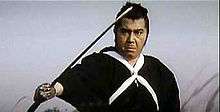Tomisaburo Wakayama
| Tomisaburō Wakayama | |
|---|---|
 Wakayama appearing as Ogami Ittō in the Lone Wolf and Cub movie series | |
| Born |
Masaru Okumura September 1, 1929 Fukagawa, Tokyo, Tokyo, Japan |
| Died |
April 2, 1992 (aged 62) Kyoto, Japan |
| Occupation | Actor |
| Years active | 1955–1991 |
| Spouse(s) | Reiko Fujiwara (1963–1965) |
Tomisaburō Wakayama (若山 富三郎 Wakayama Tomisaburō, September 1, 1929 – April 2, 1992), born Masaru Okumura (奥村 勝),[1] was a Japanese actor best known for playing Ogami Ittō, the scowling, 19th century ronin warrior in the six Lone Wolf and Cub samurai movies.[1][2]
Biography
Wakayama was born on September 1, 1929, in Fukagawa, a district in Tokyo, Japan.[1] His father was Minoru Okumura (奥村 実), a noted kabuki performer and nagauta singer who went by the stage name Katsutōji Kineya (杵屋 勝東治)[3][1], and the family as a whole were kabuki performers. He and his younger brother, Shintaro Katsu, followed their father in the theater.[1] Wakayama tired of this; at the age of 13, he began to study judo, eventually achieving the rank of 4th dan black belt in the art.[1]
In 1952, as part of the Azuma Kabuki troupe, Wakayama toured the United States of America for nine months.[2] He gave up theater performance completely after his two-year term with the troupe was over.[1] Wakayama taught judo until Toho recruited him as a new martial arts star in their jidaigeki movies.[1] He prepared for these movies by practicing other disciplines, including kenpō, iaidō, kendo, and bōjutsu.[1] All this helped him for roles in the television series The Mute Samurai,[3] the 1975 television series Shokin Kasegi (The Bounty Hunter),[3] and his most famous role: Ogami Ittō, the Lone Wolf.
Wakayama went on to star in many films, performing in a variety of roles. It has been estimated that he appeared in between 250 and 500 films.[3] His only roles in American movies were as a baseball coach in The Bad News Bears Go to Japan (1978) and as a yakuza boss, Sugai, in Ridley Scott's Black Rain (1989) that delivers a memorable English monologue that becomes a defining moment for the film, and the film's title.[3][4]
Wakayama died of acute heart failure on April 2, 1992, in a hospital in Kyoto.[1][3] He was survived by a son, Kiichirō Wakayama (若山 騎一郎) born in 1964, also an actor.[5]
Filmography
Wakayama appeared in the following films, amongst others.
1955–1969
|
|
1970–1979
|
|
1980–1991
|
|
References
- 1 2 3 4 5 6 7 8 9 10 Leous, G. (c. 2003): Tomisaburo Wakayama Retrieved on May 23, 2010.
- 1 2 3 Stout, J. (1981): "Tomisaburo Wakayama: The Anti-Hero of Shogun Assassin." Martial Arts Movies (August), 1(2):26–33.
- 1 2 3 4 5 6 7 8 9 10 11 12 13 14 15 16 Asiateca: Tomisaburo Wakayama (August 10, 2007). Retrieved on May 24, 2010.
- 1 2 Nash, Jay Robert; Ross, Stanley R. (1990). The Motion Picture Guide 1990 Annual The Films of 1989. Cinebooks. ISBN 978-0-933997-29-5.
- ↑ Sankei Sports: 若山騎一郎&仁美凌、熱愛発覚!交際5年 (in Japanese) (March 31, 2010). Retrieved on May 24, 2010. Archived April 2, 2010, at the Wayback Machine.
- ↑ Cowie, Peter (1977). World Filmography 1967. Fairleigh Dickinson University Press. p. 342. ISBN 978-0-498-01565-6.
- ↑ Hong Kong Cinema: Red Peony Gambler (c. 2006). Retrieved on May 24, 2010.
- ↑ Desjardins, Chris (2005). Outlaw Masters of Japanese Film. I B Tauris & Company Limited. p. 8. ISBN 978-1-84511-086-4.
- 1 2 Maltin, Leonard (2005). Leonard Maltin's Movie and Video Guide. ISBN 978-0-452-28699-3.
- ↑ Palmer, Bill (1995). The Encyclopedia of Martial Arts Movies. Rowman & Littlefield. ISBN 978-0-8108-3027-1.
- ↑ Maltin, Leonard (2002). Leonard Maltin's Movie and Video Guide 2003. Plume. ISBN 978-0-452-28329-9.
External links